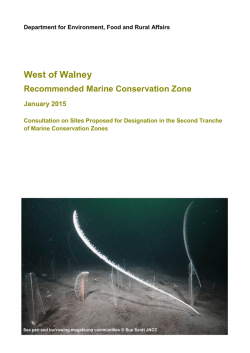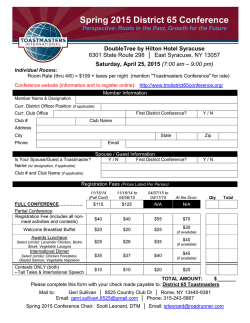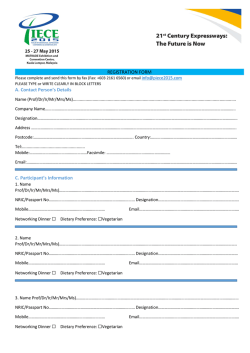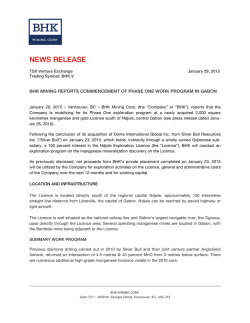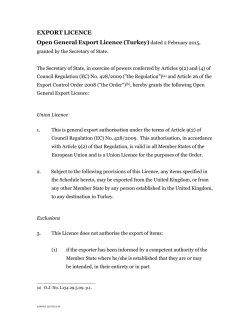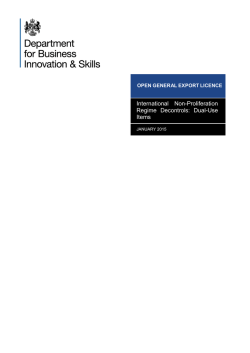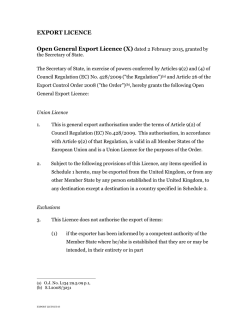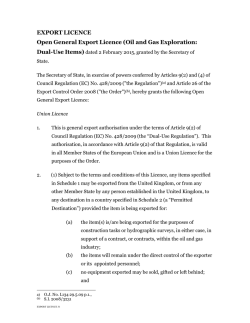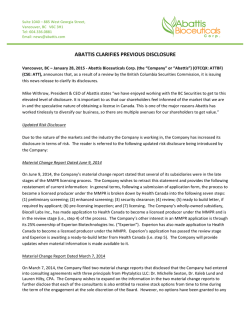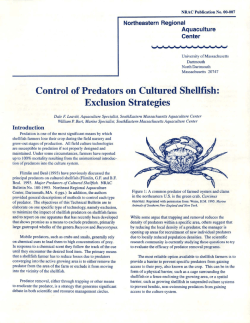
The Needles - Defra Consultation Hub
Department for Environment, Food and Rural Affairs The Needles Recommended Marine Conservation Zone January 2015 Consultation on Sites Proposed for Designation in the Second Tranche of Marine Conservation Zones Seagrass bed (Zostera marina) with snakelocks anemones © Paul Kay 1 Contents Where the site is located...................................................................................................... 3 How to comment on the consultation ................................................................................... 3 Why the site is environmentally important............................................................................ 4 What this site would protect ................................................................................................. 4 Where the features are located ............................................................................................ 5 Features that are not proposed for designation ................................................................... 7 Activities that are likely to be affected .................................................................................. 8 Ports, harbours and shipping ........................................................................................... 9 UK commercial fishing...................................................................................................... 9 National defence .............................................................................................................. 9 Archaeological heritage .................................................................................................. 10 Oil and gas ..................................................................................................................... 10 Recreational activity ....................................................................................................... 10 Activities that are unlikely to be affected ............................................................................ 11 Additional Information ........................................................................................................ 11 2 Where the site is located The Needles recommended Marine Conservation Zone (rMCZ) is an inshore site measuring 11 km². The site covers the stretch of Solent adjacent to the northwest side of the Isle of Wight, from opposite Hurst Point down to just south of the Needles. The site is named after its most prominent landmark, The Needles – the chalk stacks at the most easterly point of the Isle of Wight. How to comment on the consultation You can comment on this proposal by responding to the consultation taking place between 30th January and 24th April 2015. 3 Why the site is environmentally important This site has been recommended as an MCZ for a number of rare and fragile habitats including subtidal chalk, shallow water rock and soft sediments which support communities of algae, sponges, sea squirts and delicate anemones. Seagrass beds in both Totland and Colwell Bays support species such as the colourful Sea Hare, a small marine mollusc. Rare and threatened species such as the fan shaped algae, commonly known as Peacock’s Tail, can be found in the intertidal areas at Colwell Bay, and records of the tiny Stalked jellyfish have been found at Alum Bay. The site is also important for the native oyster, a species which has declined in numbers across the UK in recent years. Stalked Jellyfish (Lucernariopsis campanulata) © Paul Kay What this site would protect Designation would protect the following features. You can read more about the features this site protects and why they are important here. Feature General management approach Moderate energy intertidal rock Moderate energy infralittoral rock Moderate energy circalittoral rock Maintain in favourable condition Stalked jellyfish (Lucernariopsis campanulata) High energy infralittoral rock Subtidal chalk Subtidal coarse sediment Subtidal mixed sediments Sheltered muddy gravels Subtidal sand Recover to favourable condition Subtidal mud Subtidal macrophyte-dominated sediment Seagrass Beds Peacock’s tail (Padina pavonica) Native oyster (Ostrea edulis) 4 Where the features are located The following maps show the location of the features to be protected. A range of different types of surveys have been used to create these maps. More detailed information on the techniques used and the features themselves can be found here. 5 6 Features that are not proposed for designation The following features are not proposed for designation as there is currently insufficient supporting evidence. Inclusion of these features may be considered if scientific evidence becomes available: tide-swept channels, intertidal coarse sediment, intertidal sand and muddy sand, intertidal mud, intertidal mixed sediments. Native oyster (Ostrea edulis) © Paul Kay 7 Activities that are likely to be affected Management decisions are taken on a case by case basis by relevant regulators. Management will not automatically mean that economic and recreational activities will be restricted, decisions will be based on the specifics of each case. Restrictions on an activity will depend on the sensitivity of species, habitats and geological/geomorphological features (for which a site is designated) to the activities taking place in that area. More detail is available in the Impact Assessment. Sectors or activities likely affected by designation Sector Activity Affected Best Cost Estimate (£) per year Ports, harbours and shipping Port development, 15,300 navigational dredge, disposal sites. UK commercial fishing Pots and traps, 900 gill netting, long lining, tangle/trammel netting, trawling and oyster dredging. National defence Use of training site Unquantified at site level Archaeological heritage Future investigations of site Unquantified Oil and gas related activities Future development Unquantified at site level Best estimate total cost 16,200 8 Ports, harbours and shipping The site is located close to Yarmouth Port. All future licence applications made in relation to port, harbour and commercial shipping activities will need to consider the possible effects of their activities on the features designated within the site. The activities which we are aware take place, and are likely to see additional costs incurred when carrying out Environmental Impact assessments (EIAs) for future licence applications, are as follows: navigational dredging within 5 km of the site, disposal of dredged material in a site that is within 1 km of the site. This is used by the ports of Yarmouth and Lymington, disposal of dredged material in two sites that are within 5 km of the site. The impact on features in the rMCZ will also need to be considered if there is any future port development. UK commercial fishing Fishing vessels operating in this area are mainly based at Keyhaven, Lymington, Yarmouth, Cowes, Mudeford and Portsmouth. The following gears are known to be used within the site: towed gear such as trawling and oyster dredging, cuttlefish trapping, potting for lobsters, crabs and whelks, static nets such as gill netting for bass and mullet and tangle/trammel netting for sole and plaice, static gear such as long lining for bass and mullet. Management of static and towed gear may be required due to the sensitivity of the features recommended for protection. National defence The Ministry of Defence is known to make use of the site for training activities. We expect this activity to be able to continue. Activity which is harmful to features can be avoided though additional planning during operations and training. 9 Archaeological heritage Wrecks of vessels of British, Dutch, Greek, Prussian, Portuguese, Swedish, Italian and French origin are recorded within the site. The Needles’ designated wreck site has two wrecks (HMS Assurance and HMS Pomone) and is protected by a 75 metre exclusion zone. A German World War II aircraft wreck is also within the site. There is likely to be an increase in the cost for carrying out EIAs for future licence applications within this site. Following designation, these will need to consider the effect of the activity on the features designated at this site. Oil and gas Some management may be required in the future. If the site were developed for oil and gas extraction, developers would need to take into account the impact of the development on the features in the site. This would increase the cost of the licence application. As a result of this uncertainty about whether any development will take place, costs for the oil and gas sector have not been quantified at site level. Recreational activity The site provides anchorage refuge, a small number of permanent moorings in Totland Bay and ad hoc anchorage at Alum Bay. We have been unable to quantify these usages. 10 Activities that are unlikely to be affected These activities are known to take place at this site but are not likely to be damaging to the features proposed for designation at their current levels of intensity: flood and coastal erosion risk management (coastal defence), transit of ships, one active telecommunication cable intersects the site, west of Isle of Wight export cable for wind energy project could run close to the site but is not expected to intersect it1, renewables – tidal2. Additional Information To read the full consultation document, or respond to the consultation, please visit https://consult.defra.gov.uk/marine/tranche2mczs To read the advice provided by Natural England, please visit http://publications.naturalengland.org.uk/publication/5803843768025088?category=67425 52893980672 For further information, please contact Defra on 1 2 03459 33 55 77 (UK only) +44 20 7238 6951 (from outside the UK) [email protected] http://www.navitusbaywindpark.co.uk/isle-wight http://perpetuustidal.com/ptec/planning-and-timeline/ 11 © Crown copyright 2015 You may re-use this information (excluding logos) free of charge in any format or medium, under the terms of the Open Government Licence v.3. To view this licence visit www.nationalarchives.gov.uk/doc/open-government-licence/version/3/ or email [email protected] This publication is available at www.gov.uk/government/publications Any enquiries regarding this publication should be sent to us at [email protected] PB 14270 12
© Copyright 2025
